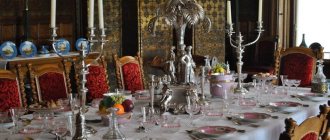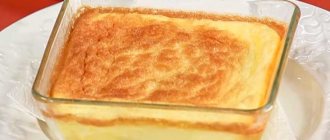General serving rules
Regardless of the size of the feast, there are several basic rules for table design. They will come in handy in any case:
- The table is covered with a tablecloth so that the edges hang down by a maximum of 30 cm. Moreover, they must be higher than the seat of the chair, otherwise the tablecloth will interfere with the guests. If the table is rectangular, the ends of the tablecloth should hang down to cover the table legs.
- It is best to cover the table with a white festive tablecloth or take a light solid one so that it looks harmonious against the background of the tableware.
- To make it comfortable for guests to sit at the table, the distance between the devices should be at least 50-80 cm.
- Plates for guests must be from the same set. If this is not at hand, choose plates of the same color.
- There should be no extra plates, glasses or cutlery on the table. You should only place those that suit the range of dishes and drinks.
Where to start
Before you start setting the table, you need to think through everything carefully and plan. Particular attention should be paid to the number of guests and the menu. Depending on what dishes and in what quantities will be served, appropriate cutlery is used.
Before setting the table, you should consider how to arrange all the cutlery
First of all, a carefully ironed tablecloth is laid out on the table. The edges of the tablecloth descend approximately 25–30 cm from the table, covering its legs. In order not to cause inconvenience to the guests at the table, they should not lower themselves to the seats of the chairs.
A soft cloth should be placed under the tablecloth itself. This is done to soften the sound of dishes hitting the table. For example, you can use fleece.
According to the rules of etiquette, it is not necessary to cover the top of the tablecloth with oilcloth. Even if it is expensive and very beautiful. However, it is permissible to buy and lay a Teflon tablecloth.
table setting in rustic style
The Teflon coating will protect the table surface from spilled drinks and greasy stains. You can easily get rid of them with a sponge. After cleaning, there will be no stains from drinks or traces of food on the Teflon tablecloth.
In certain cases, it is permissible to use underplates or runners instead of a tablecloth. Podtarelniki are various stands. They are placed under plates and cutlery. They can be made of plastic, bamboo. Plain paper placemats can also be used. Runners are narrow strips of fabric that are spread in the center of the table.
What are cutlery and dishes used for serving?
The main cutlery is forks, spoons and knives. Each knife is paired with a specific fork.
The devices are divided into 3 groups according to their purpose when serving:
- Tableware - they are used for meat dishes, dough products (but not sweets), pies, pancakes, etc. The tip of the blade helps to pick up the side dish on the fork.
- Fish - they are used to eat fish dishes. The knife is usually blunt and has an elongated shape. The fork has 4 shortened horns. In the case when there are no knives, take 2 forks.
- Dessert - they are needed for pastries, pies with sweet filling, cakes, fruit, etc.
There are also many types of spoons, each of them has its own purpose.
- Dining room - it is needed for soup, which is served in a deep plate.
- Dessert - it is used to eat sweet dishes served in bowls, dessert plates, and soups in broth cups.
- Coffee – used for coffee served in a special coffee cup.
- Tea room - it helps to drink hot drinks in tea cups: tea, coffee, hot chocolate. It can replace a dessert spoon.
All these devices are personal. They are placed in front of all the people participating in the feast.
There are a number of additional devices. They are supplied if necessary. These include:
- Spoon and fork for salads - their size is larger than that of ordinary table ones. They transfer dishes from a common salad bowl to their own personal plate.
- Butter knife – it has a curved shape and is used to scoop out butter.
- Cheese knife – its tip has several teeth. They help transfer a piece of cheese to a plate.
- Caviar spoon – serves caviar from a common caviar bowl. Its shape is similar to a scoop.
- Fork for sprat and sardines.
- Culinary tongs - help to transfer cake and pastries, take sugar, marshmallows, small candies. For the cake, instead of tongs, you can use a special spatula made in the shape of a triangle.
- Ice tongs - used to pick up ice.
- Lemon Fork – Serve when sliced lemons are available.
The dishes are divided depending on what food is in it:
- salad bowls – salads, marinades;
- trays - small snacks: sprats, butter, cheese;
- oval plates - fish and meat snacks;
- round plates - meat and vegetable snacks, canapés;
- gravy boats - sauces, sour cream;
- broth cups, deep plates, soup bowls with lids - first courses;
- small and round plates - main courses;
- small plates - desserts;
- teapots, tea cups and saucers - tea;
- coffee pots, coffee cups and saucers – coffee;
- glasses – milk drinks;
- creamers - cream;
- milkmen - milk for tea, coffee;
- vases - jam, sugar;
- rosettes – honey, jam, lemon;
- glasses and shot glasses - alcohol (the stronger the drink, the smaller the container).
Informal receptions
Table setting for an informal reception is more democratic. However, there are also some rules that need to be taken into account: the availability of space for the reception, the style of your home, the occasion for which you are organizing the reception, and the tastes of your guests.
If you take these circumstances into account, you can give free rein to your creative imagination when setting the table.
At an informal dinner, you can cover the table with a white damask or lace tablecloth, but in this case it would be quite appropriate to add some color to the table to give the reception more intimacy and take away the stiffness inherent in a purely formal dinner.
Therefore, you can put colored napkins on the table, choose the appropriate color scheme for the main table decoration, as well as for porcelain or ceramic dishes.
Usually in such cases the table is covered with a colored tablecloth or a tablecloth with a printed pattern, or a waterproof napkin is placed in front of each guest on which the dishes are placed.
If you have a set of linen, lace, straw or woven table napkins and hand wipes, it would be very appropriate to give them to guests.
Even plastic trays can work well for informal receptions.
However, whatever you decide to cover the table with, make sure the centerpiece and china will coordinate with the napkins or tablecloth.
At the same time, try to give the table originality and unique personality, reflecting your own ideas about successful table setting.
At an informal reception, just like at an official one, it is quite appropriate to light candles, only it is better to place them not in candelabra, but in candlesticks.
They can be of any color that harmonizes with the tablecloth or with the napkins laid out on the table, but the main thing is that the candles are located at a sufficient height and do not blind the eyes of diners.
The hostess (in some cases she is helped by one of the guests) removes the candles after the end of dinner.
The originality of table setting can also be manifested in the design of its central decoration. For example, an ikebana-type decoration on a brown tablecloth with orange or beige napkins looks good.
Wide red stripes on a white tablecloth and large red poppies in a vase in the center of the table will greatly liven up the atmosphere of your reception, especially if it is held in winter.
You shouldn’t limit yourself to an ordinary vase of flowers, even when they look beautiful.
As at an official reception, all devices for guests should be located symmetrically and at the same distance from one another.
The main difference between table settings for formal and informal receptions is that in the second case there are fewer cutlery, since fewer dishes are served to the guests.
Most often, wine is offered in one type, less often - two, so a water glass and one or two glasses for wine are placed in front of each guest.
It happens that wine is not served at all, in which case glasses for iced tea or just water or beer mugs are appropriate.
If you don't have butter plates that match your dinnerware, buy regular glass ones.
A spilled piece of butter or a slice of bread lying on your plate, generously flavored with fish sauce and decorated with salad peas, will not look very aesthetically pleasing.
For the same reason, clean plates should be served with the salad if guests have previously eaten a dish generously topped with gravy.
The salad can be placed on the same plate where the fried steak or chicken cutlets were previously placed, but not the roast lamb.
If guests are invited to an informal three-course dinner, the following utensils are usually placed on the table before each of them:
- 2 forks (the one on the far left is for a hot dish served at lunch, and the one closest to the plate is for dessert or salad)
- dinner plate
- Salad plate (to the left of the forks)
- 1 knife (next to the plate on the right - for steak, chop, chicken or game; usually called a "steak knife")
- 2 spoons (dessert spoon - to the right of the knife, for soup - even further, to the right; you, of course, remember that the utensil lying closest to the plate is used last)
- 1 saucer with butter
- 1 wine glass or tall glass for water
- 1 wine
- An ashtray even if no one smokes
- Napkins in the center of the table
If you are going to serve coffee at dinner, the cup and saucer should be placed to the right of the person sitting at the table, and the coffee spoon should be to the right of the saucer.
At an informal dinner, serving plates are not placed, except when the first course is served with shrimp cocktail, fruit cocktail and other dishes, which are usually poured into a wide glass goblet with a stem, or soup.
While guests are seated, a dinner plate is not placed in front of them, since it is customary to serve warmed plates for first courses.
It is not necessary to place a dessert spoon and fork (you can limit yourself to just a spoon) next to the plate.
As at a formal dinner, they can be brought along with the dessert plate or, according to European tradition, placed horizontally in the center in front of each guest, to the right of the glasses and cups!
These photos show what dishes and cutlery look like for proper table setting:
How to lay a tablecloth
Textiles on the table set the tone for the entire setting. A tablecloth as a background can emphasize the solemnity of the moment, or, conversely, ruin the mood. Therefore, it must be spotlessly clean, intact and without scuffs. It is checked in advance, washed and ironed.
- How to choose the right non-stick frying pan - types, advantages, disadvantages
Which knives are best to buy for the kitchen: top rating of kitchen knives
Which pans are the best and most harmless?
According to the general rules of table setting, the tablecloth is chosen in accordance with the occasion of the celebration:
- A formal reception calls for white damask fabric. This is the name given to a linen or cotton tablecloth woven with shiny convex patterns. You can replace it with smooth linen or linen, but damask looks more solemn. A soft lining is spread under the main tablecloth so that cutlery and plates do not knock when serving and during the meal. For this purpose, use felt or felt, cut to the size of the tabletop. To set the table at home, you can use a sheet folded several times.
- A gala dinner in an old mansion or a room designed in the style of a “noble nest” can be decorated with a lace or embroidered tablecloth. However, you should not choose bright and lush patterns.
- Light, elegant and sometimes bright embroideries are more suitable for calm family celebrations and setting a festive table at home. In this case, you need to make sure that the pattern is positioned strictly symmetrically relative to the contours of the table.
- Modern etiquette allows the use of colored tablecloths matched to the porcelain and napkins. However, it is not advisable to get too carried away with bright colors. Soft pastel shades chosen taking into account the style of the room, decor and occasion of the celebration will look good. For example, bluish and greenish tones will add coolness to a sunny dining room, and shades of yellow will warm you up in the winter cold.
- Colorful, brightly colored tablecloths will be more than appropriate at a children's party or themed party. Setting the table with rich tones is acceptable for breakfast or tea.
Formal reception
Gala dinner
For family celebrations
For children's parties
The tablecloth should be ironed before use, even if it has been stored very carefully. Traditionally, vertical and horizontal folds running strictly in the center are smoothed out. When placed on a table, they should divide the tabletop into four equal parts, aligning the center of the furniture with the center of the canvas.
How to properly set a table with a tablecloth:
- shake it over a piece of furniture to create an air gap;
- align the centers of the table and tablecloth;
- place it so that the corners of the canvas cover the legs, and the edge goes down 30-50 cm (less is not aesthetically pleasing, more is inconvenient).
At the end ends of the dining table, the tablecloth can hang a little lower unless there are guests sitting there. For a buffet table, a fairly long tablecloth is usually used, since there are no seats at the table. However, under no circumstances should it touch the floor.
Types of serving
The table decoration may vary depending on the time of day and the nature of the festive dinner. In this case, banquet, buffet, tea and coffee serving are distinguished. However, certain differences exist. Breakfast requires a minimum number of dishes to serve the table, and during dinner there is always a large number of dishes and cutlery on the table.
For breakfast (+ Sunday breakfast)
This is the simplest type of table setting. Snack plates are placed first, then cups, glasses and small saucers. A teaspoon is placed on top of the latter. If your family uses egg cups or butter bowls, don't forget a teaspoon. A deep bowl (for porridge or cereal) is placed on a snack plate.
Sunday breakfast cannot be imagined without tea, which is why there is a coffee pot or teapot in the center.
You can decorate the table with flowers, unusual napkins and various decorative elements. Family Sunday breakfasts are becoming a good tradition in many homes; they bring loved ones closer to each other. The key point in setting the table for breakfast is to create a good mood and comfort during the meal.
Dining
There are several types of table settings for dinner. It all depends on the number of dishes and their nature. Cover the table with a white tablecloth, place one flat and one deep plate (for soup or salad). If there are dishes on the menu that cannot be eaten from shared dishes, add a snack plate. Arrange cutlery according to proper etiquette. Beautifully folded napkins are perfect for table decoration.
A distinctive feature of the table setting for dinner is the installation of a salt shaker and other items for spices and seasonings.
Full evening
You can set the table not only for family members, relatives or friends, but also for unfamiliar guests. Preliminary serving in accordance with all the canons is the key to the success of any dinner party, because everyone should be comfortable and comfortable. The decor of the table creates a special atmosphere that is conducive to intimate conversations, wonderful memories and plans for the future.
To make the holiday a success, you must follow the following rules of table etiquette:
- A perfectly clean, ironed tablecloth. It is advisable that the product be made of thick fabric (this will prevent the dishes from clinking when dropped and protect the surface from spilled liquid).
- To decorate a festive table, it is not acceptable to use dishes and cutlery of different colors. Give preference to monochromatic options from one set. All decorative elements (vases, coasters, napkin rings) should be sparkling clean, the same goes for dishes.
- It is prohibited to serve corked bottles of champagne or wine. All alcoholic drinks are served in open bottles and then poured into wine glasses. One cloth napkin is placed next to the glasses.
Banquet room
Banquet table setting is not much different from a full evening table setting, but there are some features of this type of decoration. So, shallow plates are placed at a distance of 1 cm from each other, starting from the center, first on one side, then on the other. They should be clearly opposite one another. Snack and pie saucers are placed on these plates. The next step is to place the cutlery at a distance of 0.5 cm from the shallow plate.
Article on the topic: How the table is set in different countries of the world: features of table etiquette
A distinctive feature of the banquet is the decoration of the table with special personalized cards, which indicate the personal information of the event participant. They are located to the left of the wine glasses.
Buffet room
Buffet table setting is becoming increasingly popular; it is used at private parties, official events and during informal communication between business partners. There are two options: one-sided and two-sided serving. Each has its own distinctive features. In the first case, the table is decorated only on one side and is placed near the wall. The second one is usually used at corporate events, weddings and anniversaries.
Serving is done on both sides in accordance with a special scheme. The main thing is that you can take the dish without making much effort (that’s why the table occupies the entire central part of the room).
When serving a buffet, it is especially important to maintain equal intervals between cutlery and other items. They begin to set the table by arranging glass and crystal dishes, after which vases with flowers and bottles of alcoholic beverages are placed in the center of the table.
The labels on the bottles should be facing the same direction. In certain situations (when there are many guests), a separate table is allocated for drinks and snacks.
Coffee shop
The nature and basic provisions of coffee etiquette directly depend on the drinks chosen. It can be Turkish coffee, classic coffee, Italian expresso. Stronger drinks prepared on the stove are served in porcelain cups from one set. A geyser coffee maker can help you create the perfect coffee drink - this is an ancient secret of the peoples of the East.
When pouring coffee, make sure that the cups are only two-thirds full (this allows guests to add a little milk or cream).
Coffee table setting includes three elements - a saucer, a cup and a teaspoon. Additional items include a dessert plate that can hold cakes, and cutlery for fruit or sweets. The arrangement of dishes should begin with desserts. When all the guests have arrived, you can start preparing drinks.
Teahouse
If each guest is assigned a certain place at the table, then the basis for serving is the principle that a cup and saucer with the necessary list of cutlery and a small plate for desserts are placed in front of each participant in the tea party. The main dish is located in the center of the table. This could be a bowl of pastries, a cake, an apple pie, a bowl of fruit.
Particular attention is paid to the decor; all elements must be evenly spaced around the perimeter of the table. It is customary to leave the teapot and the kettle with boiling water on the edge. In the case of a samovar, it is placed clearly in the center.
When inviting friends for tea, make sure that you have enough tea sets (it is better if there are 1-2 more than the expected guests).
In conclusion, it is worth adding that table setting is, first of all, an individual design of the surrounding space. Don't limit yourself to just one arrangement of objects; show your imagination and decorate the table with incredible decor and fresh flowers. An informal creative approach and adherence to the classic rules of dining etiquette are the key to a successful festive dinner, Sunday morning and friendly gatherings with friends over a cup of aromatic coffee.
10 etiquette secrets from aristocrats (1 video)
Table setting and decoration (60 photos)
What and how to use?
The greatest difficulty is most often caused by laying out and using cutlery. A rule can help here: devices are always used in the direction from edge to center and from right to left. This means that when there is an expected change of dishes, the cutlery that lies farthest from the main plate will be used first. When in doubt, first take the device located on the right.
Arrangement rules
Serving is a whole science with a centuries-old history, which has its own rules and exceptions. However, if you remember the basics, then setting the table correctly will not be difficult at all:
- The dishes are placed on the table in a strictly defined sequence. First - earthenware and porcelain items, then - cutlery. Finally, they place objects made of glass and crystal.
- It is necessary to lay out everything so that the closest thing is what you need first. When planning several courses, dishes and cutlery are arranged in the order in which the food will be served. At the same time, it is not necessary to pile everything on the table at once. It is enough to put the utensils intended for serving dishes for the first and second courses. Dessert sets can be arranged later - after the main ones have been removed.
- The knife should be placed so that its blade is turned towards the dish.
- According to etiquette, the glass (glass) should be located above the knife. If several types of glasses are used, then they are all placed side by side.
- Forks must be placed on the left side of the plate.
- Spoons are always located to the right of knives.
- If you plan to serve Italian dishes, there should be a bread plate on the table.
- If there is soup on the menu, a soup spoon is placed between the knives for appetizers and fish.
In addition, there are several more generally accepted rules governing the arrangement of individual serving items.
Dishes
According to the rules, the layout of dishes should begin with the plates. In this case, they must be placed so that they are 1.5-2 cm from the edge of the table. The distance between them should be approximately the same. It is believed that dishes should be placed at intervals of 50 cm - so that those sitting at the table feel comfortable.
Plates with cutlery should be placed opposite each chair. Their number depends on the variety of the menu and the type of meal. For example, one plate will be enough for a regular snack, but two plates will be served for lunch and dinner.
Plates of smaller diameter are always placed on top of larger ones, which allows you to quickly replace them while saving space on the table.
Spoons and forks
Cutlery is laid out after the plates. They must be placed on the sides of the main plate, with the concave side facing the table.
Forks are placed on the left side, spoons and knives are on the right. A teaspoon can be placed on top.
It is important to place on the table only those devices that are really needed. Most often, for a regular meal, one knife, one fork and two spoons (for a hot dish and dessert) are enough. If necessary, this set can be supplemented with special devices.
Glasses
The most commonly used glassware for drinks is glasses and wine glasses. They can be different in shape, volume and have different purposes, which should also be taken into account when preparing to meet guests:
- Classic elongated glasses with a volume of 120-200 ml are intended for champagne sparkling wines. served for refined champagnes. It must be cooled before filling.
- The glass, slightly different from the classic one with an increased volume and a slightly narrowed neck, is served for sophisticated champagne wines. It must be cooled before filling. And fill it no more than 2/3.
- For white wine, use glasses with an elongated bowl on a narrow stem, with a volume of 180-260 ml.
- Red wine is poured into wider and more open glasses.
- Cognac glasses can have a classic shape (snifters) or a tulip shape.
Liqueur glasses, vodka glasses, beer glasses are also used - everything here will depend on the preferences of the guests and the suggestions of the hosts.
Decor
Decor will help complete the serving and give it completeness. The main decorative element is napkins, which can be placed in a glass of water, placed next to the plates or placed on top.
For a quiet family lunch, you can use large napkins; for breakfast, smaller ones.
For large celebrations and holidays, napkins can be folded in the shape of flowers or tied in an original way. The color and design of the napkins can be absolutely any, the main thing is that it is in harmony with the overall design picture.
In addition to napkins, it is customary to use vases with flowers, candles or themed decorations for table decoration.
Sequence of table setting
The table setting for dinner, the layout and types of utensils depend on the time of meal.
Serving algorithm:
- The table is covered with one large tablecloth or small ones, individually for each person.
- Plates are placed in front of each guest seat.
- Lay out cutlery.
- Cups and glasses are placed near the plates.
- Dishes are brought to the table.
- Place napkin holders on the countertop.
- Spices are set out: salt and pepper shakers. They are not used when serving dessert and tea tables. Also, do not put these items if there is a sweet feast.
If some additional decorative decoration will be placed on the table: a bowl of fruit or a candy bowl, then they are placed at the very end. They need to be positioned so that they do not interfere with the main meal, but at the same time they are not located at the very edge of the table.
Tablecloth
The tablecloth in the table setting has aesthetic significance. It is pleasant to eat behind beautiful furniture; besides, the dishes will stand more stable on the fabric than on the slippery surface of the tabletop.
For serving, you can take a waterproof tablecloth. This will make it easy to clean up spilled food. You can use a napkin made of natural fabrics: linen or cotton.
Such fabrics will have the following advantages:
- Hygroscopicity. This means that the fabric will be able to absorb excess moisture.
- Strength. The fabric can withstand mechanical damage.
- Hypoallergenic. The composition of such fabrics does not contain substances harmful to humans.
The color of the tablecloth may vary. But a light fabric will look best on the table. You can take it with embroidery or floral patterns.
Dishes
The first courses are served in deep plates with a pattern or a solid color. The dishes should fit into the overall picture of the serving. The plates should not be blue and the tablecloth orange.
In addition to deep plates, they use:
- Oblong - for general use. A dish can be laid out on them for anyone to take.
- Herring tanks – designed for fish products.
- Pies are an alternative to a bread box. The diameter of such dishes is 17.5 cm. They are used for buns, bread or croutons. Should be to the right of the child's main plate.
- Snack bars - for hot dishes or cold snacks.
- Dessert - for berries and fruits.
The material of the dishes must be of high quality. The most commonly used plates are:
- Porcelain.
- Faience.
- Ceramics.
If the table setting will be done outside, you can take plastic utensils. This option is most suitable for organizing a picnic in nature. You can also use laminated cardboard dishes.
Devices
Serving utensils can be divided into the following groups:
- Fruit - knife and two-pronged fork. They are needed to eat fruit.
- Fish - a knife in the form of a spatula and a fork with shortened teeth.
- Canteens - for soup and main courses. The set includes: knife, fork and spoon.
- Dessert. The set consists of a three-pronged fork, a small spoon and a narrow knife.
- Snack bars - they are used to eat cold dishes and snacks. This group includes fork and knife.
It is not necessary to put all the cutlery on the table. It is enough to use only those that are useful.
Glasses
Any glasses can be used:
- Glass.
- Plastic disposable or reusable.
- Made from laminated cardboard.
Glasses can replace basic cups.
Napkins
Napkins should be on the table regardless of the purpose of serving. You can always wipe your mouth or hands with them.
In this case, napkins can be arranged in different ways:
- Individual for each person. In this case, use a cloth napkin and place it under or on the plate, having previously folded the cloth.
- Place the napkins in a common napkin holder. In this option, paper handkerchiefs are used.
Napkins can be chosen in different designs: colored, ornamented or embossed.
Decor and decorations
In addition to basic cutlery and dishes, decorative items are often placed on the table. They make the table more elegant and festive.
For this purpose you can use:
- Vases with flowers.
- Flashlights.
- Candlesticks.
Homemade decorations will look very beautiful. They can be made for any occasion. For example, you can put decorations made of painted pine cones on the winter table.
How to arrange cutlery
Proper serving of cutlery will help you make a good impression and pay attention to your guests. Use 1 set to ensure the designs match. Consider the purpose of the items used, make a choice depending on the dishes offered. Consider which knife is not served when setting the table, do not use unnecessary cutlery.
During meals
Before starting a meal, you must place your fork on the left side of the plate, tines up. The larger one is placed closer to the dish.
The knife, teaspoon and soup spoon should be on the left. The blade is directed towards the dish. If more than 3 dishes are served, all cutlery should not be laid out at once. They will be removed as needed. The used ones will be taken away.
The dessert fork and spoon are placed opposite the eater. The distance between adjacent objects should be 1 cm. The gap between the cutlery and the plate is the same.
After meal
Separate rules on how to place a fork and knife exist to complete a meal. Using cutlery, you can leave a message for the waiter. If the items lie parallel to each other, the guests liked the service and food. In situations where the cutlery is placed crosswise, the visitor was dissatisfied. To show that the meal is not completed, there is no need to take away the leftover food; the spoon and knife are placed with the end on the edge of the plate and the base on the table.
How to set a table at home
Generally accepted etiquette rules for table setting provide for the presence of a special serving plate, which differs in diameter from all others.
It is necessary in order to protect the tablecloth from accidental grease stains or drops; also for these purposes, you can first put a protective backing on the table.
I recommend reading Table setting in kindergarten rules and features
A serving plate may be missing if we are talking about a regular family dinner with relatives.
The serving plate is placed on the table first so that it is 2 cm from the edge of the table. Depending on the serving, a salad or appetizer, soup or broth cup is placed on the main plate. To the left of this plate a small flat pie plate is placed, and a butter knife is placed on it parallel to the table line.
Next, all the cutlery is laid out on both sides of the plate, namely, forks are placed on the right side, knives and spoons on the left side. The blade of the knives should be facing the plate, and the tines of the forks should be facing up. When arranging cutlery, you must follow the rule: the ones that are used first should be those that are furthest to the plate. Dessert utensils are placed behind the serving plate.
The next step is to properly set the table with identical glass or crystal glasses and wine glasses. Each of them has its own purpose:
- narrowed flute champagne glass - for champagne, sparkling wines and cocktails based on them;
- cognac glass - for cognac drinks;
- convex wide glasses - for red wines;
- small straight glasses - for white wines;
- martini glass – for martinis and cocktail drinks without ice;
- shot glass - for liqueurs;
- tall glasses - for juices, carbonated drinks;
- wide low glass - for whiskey, strong alcoholic drinks with ice;
- beer mug or glass - for beer and cocktails with beer.
Glasses should be placed to the right of the serving plate. There should be an identical set of glasses next to each plate, and they should match the range of drinks on the table.
How to use a napkin
Any table is always served with napkins. However, they come in two types:
- fabric;
- paper
Cloth napkins are placed on a plate. Most often they are folded in funny or unusual shapes. After sitting down at the table, such a napkin should be laid out on your lap in order to keep your clothes clean.
You should not tuck the napkin into your collar. Such behavior is considered bad manners and is not welcome in public catering establishments. By placing this napkin on your lap, you can put the dish on your plate.
You should wipe your fingertips on the same napkin, located on your knees, if for some reason they get dirty. Although it is not recommended to touch food with your hands, in some cases it may be necessary to remove a fish bone from your mouth, break off a piece of bread, and so on. After such manipulations, you should wipe your fingers on a napkin, but you should use only one of its edges. You should wipe your fingers discreetly, carefully, and exclusively under the table. You cannot wipe your mouth with such a napkin. Use disposable paper napkins for your mouth. They are usually placed in a napkin holder on the table. This napkin should only be used once.
You cannot blow your nose into napkins at the table. If such a need arises, you should apologize, get up from the table and go to the toilet. After this, it is recommended to wash your hands with soap.
If you need to take a break during lunch, fold a cloth napkin placed on your knees in half or three times and place it on the back of the chair. This napkin should not be placed back on the plate. Used paper napkins should be placed in a dirty plate.
Rules for proper festive table setting
“Stylish tableware for a festive table setting will give the feast a warm, friendly atmosphere”
in this case, the festive table fits perfectly into the design of the room
The ceremonial feast is organized not only for the owners of the house, but also for invited guests.
Guests should be comfortable and comfortable at the table. If the serving rules are observed, the feast can be considered a great success.
What you need to know
The festive table should not be filled with extra dishes
Any housewife must comply with the following requirements:
- There must be a clean and ironed tablecloth on the table. It would be a good idea to place a soft, dense cloth underneath it. This will muffle the possible clatter of dishes on the table if the container tips over. In addition, the surface of the table will not be damaged by liquid spilled on it. If the table is made of expensive and valuable wood, then it is permissible to do without a tablecloth altogether.
- All tableware for a festive table setting should belong to one set. It is unacceptable for dishes and cutlery on the table to be of different colors and sizes. Dishes must be spotlessly clean.
- Plates and cutlery are laid out in accordance with the serving of dishes.
- You shouldn’t fill your holiday table with extra dishes and cutlery. They will not be needed during the feast, they will take up extra space and ruin the entire careful serving.
- All alcohol is served on the table in pre-opened containers. But there is one exception: champagne should be opened just before serving.
- Each participant in the feast should have one cloth napkin and several paper napkins.
- The hostess herself serves the first course to the participants of the feast. She pours it into plates from a special tureen. One of the family members or guests can help her by handing out full plates. To do this, you need to approach each participant in the feast from the right side.
- Guests serve the second course on their plates themselves.
proper table setting will highlight the skill of the hostess
Dishes during the feast should be served in the following order: first appetizers and first courses, then fish dishes, meat dishes. Finally, they bring out a sweet dessert or fruit, and offer tea or coffee.
If the festive table is decorated competently and tastefully, it will emphasize the skill and skill of the hostess. In addition, stylish tableware for festive table setting will give the feast a warm, friendly atmosphere.
Cutlery signals
The ability to make signs with cutlery in a restaurant allows the visitor to discreetly communicate with the waiters. Knowing the rules for using cutlery, you can avoid misunderstandings with waiters and always have the desired result on the table. The arrangement of the cutlery indicates to the waiter whether you liked the dish or not, whether to put away the fork and knife after eating or not, and so on. Knowing how to correctly place a fork and knife to show these symbols, the visitor leaves a good opinion of himself and shows a high level of culture.
There are several basic rules:
- The placement of a fork and knife when the diner wishes to return to eating a little later and does not want his plate to be removed occurs on the plate. The ends of the fork and knife should touch the side of the plate. If there is no food on the plate, it is allowed to scrape the edges of the cutlery. In this case, the waiter will not take the plate away.
- After finishing the meal, you should place the cutlery on the plate parallel to each other. The distance between the instruments shows whether the visitor likes the dish or not. The greater the distance between the fork and the knife in this position, the larger the portion and the customer’s satisfaction remained at a high level.
- Having finished the meal, both instruments are placed to the right of the plate parallel to each other so that they touch, and the waiters take them away. This way, placing the cutlery after finishing the meal is convenient for the waiter - he will come to the right and take away the plate.
After leaving the restaurant, according to etiquette, it is customary to use the last cutlery to indicate whether the client liked the service. If you really like it, you should fold the fork and knife with their sharp ends to the right, parallel to each other. This placement is in the middle of the plate. If you don’t like the dish, you should place the fork and knife on the plate, crossing them at the very end. However, it is important to move the knife between the middle tines of the fork - this designation indicates a negative impression of the dish. If the dish was good, but the waiters were impolite or unfriendly, the fork and knife are crossed with each other at the end, but both tools are with the handles facing up.
Any arrangement of appliances in which their handles point upward rather than downward indicates poor maintenance. Any visitor to a catering establishment can use all cutlery correctly if desired. The ability to stack forks and spoons correctly on the table is a sign of good manners.
What to remember at the table after a meal
- In many countries, it is customary to thank the cook for his efforts, even if the food is not entirely to your taste.
- The linen napkin should be carefully folded next to the table, to the right of the plate.
- If after eating there are pieces of food left in the mouth, then you should not use a toothpick at the table. You need to take it and gallantly retire to the restroom.
- Avoid extraneous sounds when lowering metal objects and utensils or touching edges.
- There is no need to lean back in your chair as a sign of the end of your meal; this indicates excessive saturation, which does not characterize the visitor in the best way.
Different positions of your knife and fork can tell you a lot more about your relationship with food than you do.
So, the rules for using cutlery according to etiquette largely depend on the type of item and its purpose. Some types of food can be consumed without them, but you should be absolutely sure of this, otherwise you may come across as an uncultured guest who does not respect himself and others.
The ability to use cutlery speaks about a person’s cultural level.
Why do you need table setting?
Setting the table for dinner (the pattern for kindergarten children is not complicated) helps to conveniently arrange the dishes and cutlery. This will make eating easier and more beautiful. While serving, children learn how to properly use spoons, forks and in what order to eat dishes.
In kindergarten, serving helps:
- Develop a careful attitude towards food.
- Introduce children to work and self-care.
- Develop basic eating skills. Children learn to eat carefully and not put large pieces of food in their mouth.
Table setting allows children to understand that it is more pleasant to eat in a neatly arranged order of things. This helps to join the culture of food and communication.
How to teach etiquette to a schoolchild
Children begin to learn table manners at the age of 5-7 years. For younger schoolchildren, it is most effective to conduct classes in a playful way - for example, organize a festive banquet for toys. In groups you can organize role-playing games and play out situations. Having memorized the rules using examples, the child will be able to more easily apply them in life. It is best to vaccinate them from an early age, since later it will be difficult for a person to unlearn old habits.
It is useless to force a student to learn etiquette norms by heart - they need to not only be known, but also applied. It will be more effective to instill good manners by example. During feasts, you can make comments to the child and point out his mistakes, but without attracting the attention of other guests.
Etiquette lessons for schoolchildren should be visual. Simply explaining behavioral norms to students is most often useless—you need to back them up with examples and real-life situations. It is also worth making it clear that etiquette exists for a reason - it is necessary to ensure the safety and comfort of people.











